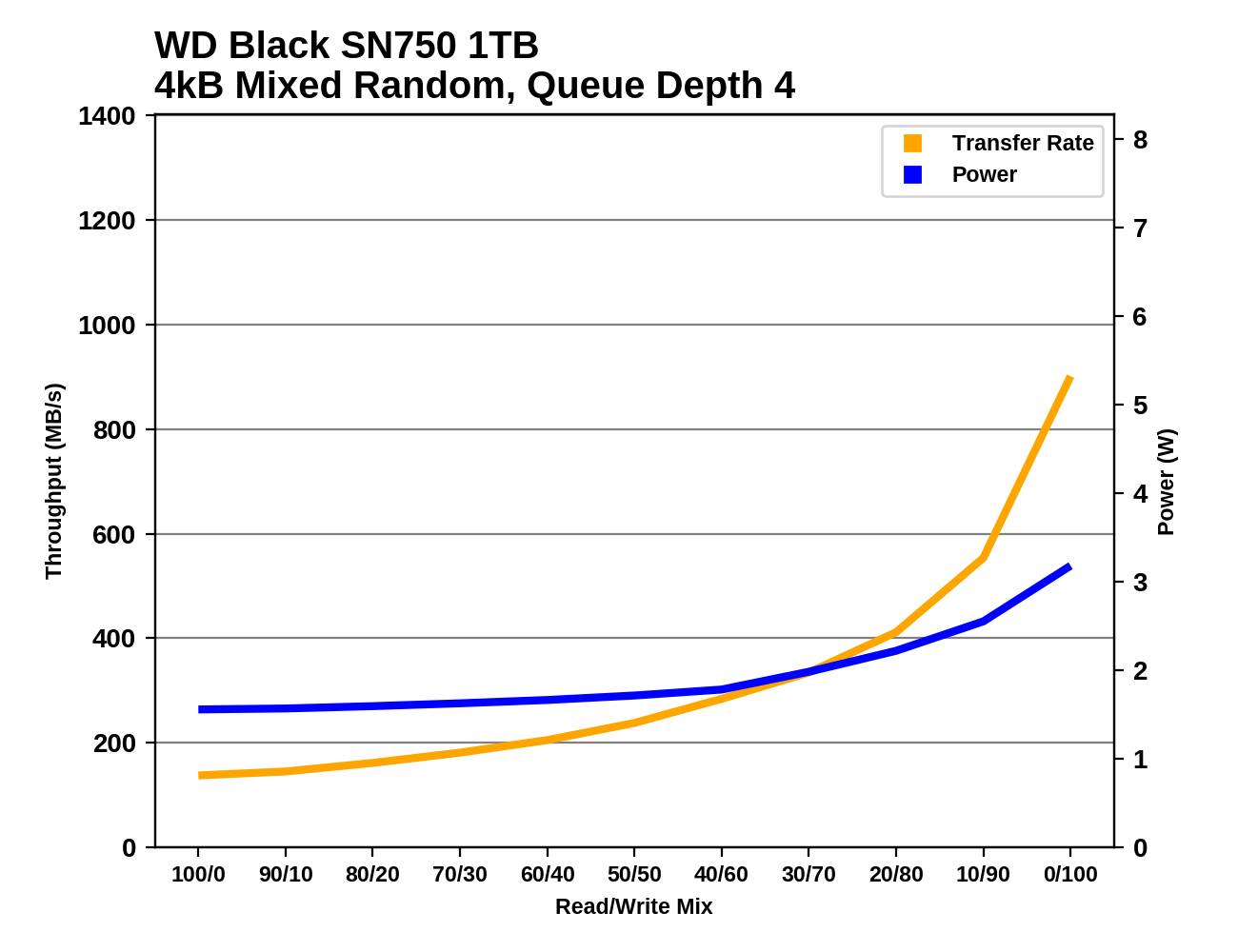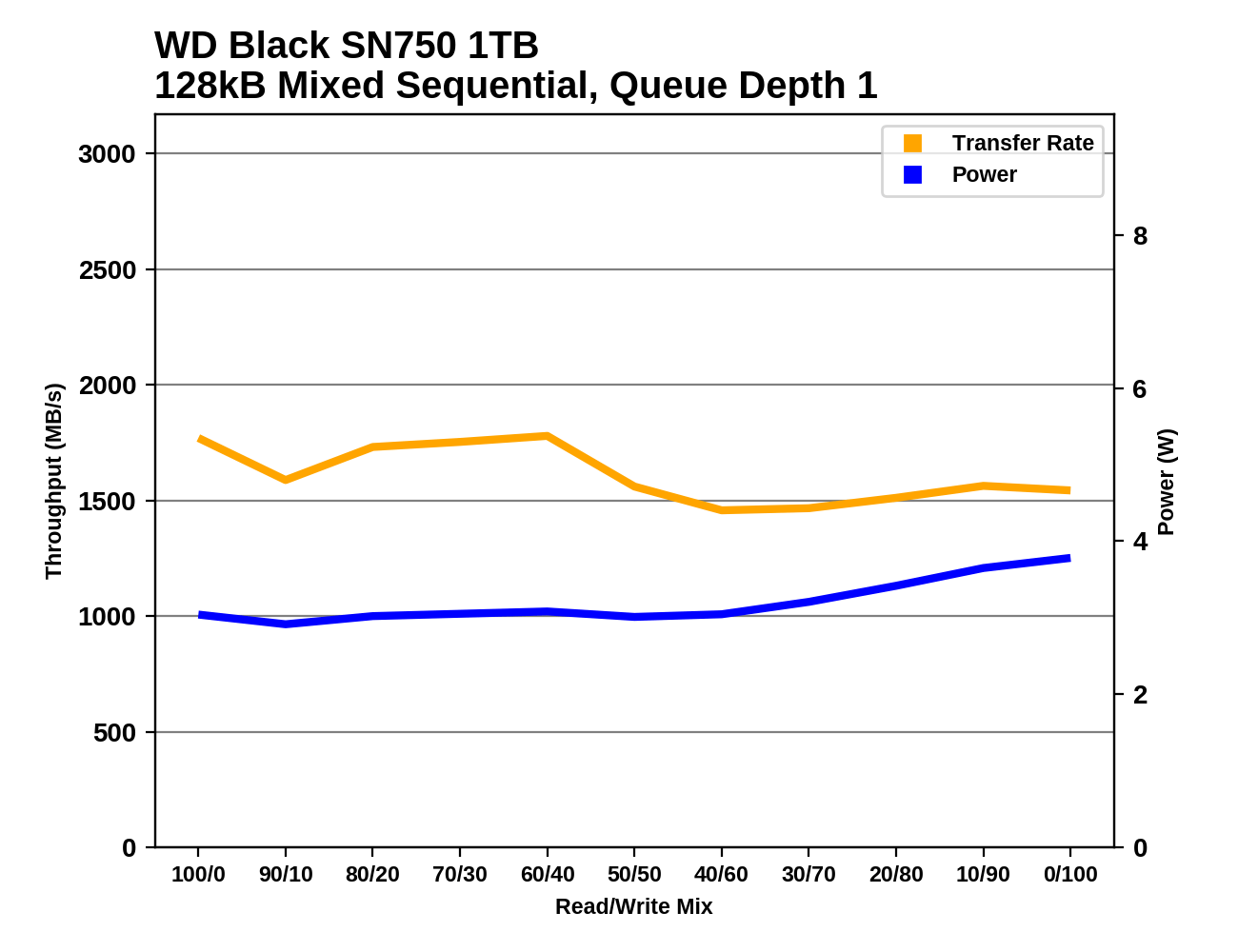The Western Digital WD Black SN750 SSD Review: Why Fix What Isn't Broken?
by Billy Tallis on January 18, 2019 8:01 AM ESTMixed Random Performance
Our test of mixed random reads and writes covers mixes varying from pure reads to pure writes at 10% increments. Each mix is tested for up to 1 minute or 32GB of data transferred. The test is conducted with a queue depth of 4, and is limited to a 64GB span of the drive. In between each mix, the drive is given idle time of up to one minute so that the overall duty cycle is 50%.

The overall mixed random IO performance of the Western Digital WD Black SN750 is about the same as the previous version, as well as the Toshiba XG6 and HP EX920. These are the second-tier drives that are a bit slower than the SM2262EN and the Samsung 970 EVO.
 |
|||||||||
| Power Efficiency in MB/s/W | Average Power in W | ||||||||
The SN750 and the Toshiba XG6 have almost exactly the same overall performance on this test, but the XG6 has 7% better performance per Watt. The second place score of the SN750 is still well above average—ignoring the outgoing WD Black, the SN750's performance per Watt is about 26% better than the next best TLC drive.
 |
|||||||||
The two flash-based drives that substantially outperform the SN750 on the mixed random IO test are faster through almost all of the test's phases, while the drives that are roughly tied with the SN750 tend to be a bit faster through the more read-heavy parts of the test and fall behind when the workload becomes very write-heavy.
Mixed Sequential Performance
Our test of mixed sequential reads and writes differs from the mixed random I/O test by performing 128kB sequential accesses rather than 4kB accesses at random locations, and the sequential test is conducted at queue depth 1. The range of mixes tested is the same, and the timing and limits on data transfers are also the same as above.

The WD Black SN750 improves upon its predecessor's performance on the mixed sequential IO test, but not quit enough to take the top spot on the performance ranking. The Samsung 970 EVO is a few percent faster overall.
 |
|||||||||
| Power Efficiency in MB/s/W | Average Power in W | ||||||||
The SN750 has a clear lead in the efficiency scores, improving upon the previous record set by last year's model that remained largely unchallenged, though the Toshiba XG6 and Corsair MP510 did come close. The average power consumption of the SN750 is slightly higher than the previous WD Black but that is more than offset by the higher average performance.
 |
|||||||||
The WD Black SN750 only barely drops below 1.5GB/s at its worst during the mixed sequential IO test, and it performs a bit better during the more read-heavy half of the test. The other drives all have worst-case performance that's slower than the SN750 by at least a few hundred MB/s, but many of those drives also have significantly better peak performance, most often at the read-heavy end of the test.










54 Comments
View All Comments
joesiv - Friday, January 18, 2019 - link
Micron was the manufacturer I was referring to.Other brands we've used which didn't exhibit the same poor endurance, ADATA, Kingston, Swissbit, Crucial
Some of them probably even use Micron NAND. I bet the NAND is fine on the Micron model we were using, perhaps the hardware is good but the software (firmware) wasn't? Of course we haven't tested every brand/model as our requirements were very specific, so I am sure there are other Micron models that are totally fine (kind of why i'd love to see anandtech include some endurance results, to help weed out the outliers)
sdsdv10 - Friday, January 18, 2019 - link
Interesting you write that Micron has problems and Crucial doesn't, as Crucial is just a consumer brand name for Micron Technology Inc.joesiv - Friday, January 18, 2019 - link
Well they were different models. The crucial was an old model that we were replacing with something new, since the old crucial drives were no longer available. It would be interesting to compare a crucial equivalent model though, I wonder if they share firmware.sovking - Friday, January 18, 2019 - link
Of course, these improvement will be welcomed, and I would like to see more in clear the steady state behaviour too.Regarding the endurance, we should take into account that most of these reviews are about consumer products. An NVME SSD for enterprise market has totally different performance: e.g regular steady state performance, higher endurance, higher reliability and so on. Sometimes, it's possible to find lightly used enterprise NVME drives at bargain price or at the cost of consumer drive: when this happens I prefer these drives.
joesiv - Friday, January 18, 2019 - link
I think the role of a "consumer" is not perfectly defined these days. Are they the same as a "power user?" It would seem that more and more consumers are starting to do more and more serious workloads on their PCs. Obviously this is anecdotal, but with all the processing power at our disposal these days ("consumer" CPU's having 16 threads). People probably don't even know what the applications or services that they are running on their PC are doing.For example, a lot of commonly used applications will be running with a database system as their backend, whether it be a more simple sqlite database, or something more serious, those can be very write heavy, and they're often configured by the application without the user even knowing it. I'll bet that a lot of users even have web services running on their PC's, without actually thinking about it, all these API's that allow you to connect to your mobile devices/streaming appliances.
I'll bet a lot of people reading anandtech reviews even have their PC's running as a fileserver, or have a dedicated machine for such duties.
A lot of this stuff is stuff is stuff would be considered "enterprise" computing of yester-years. Why does anandtech run transcoding, rendering and "destroyer" style tests in their "consumer" reviews? Because it's relevant to some portion of the purchasing community.
Oxford Guy - Friday, January 18, 2019 - link
Considering how consumer parts have had endurance problems...Examples: OCZ Vertex 2 (with 64-bit NAND), Samsung 840 128 (terrible steady state performance, too), Samsung 840 and 840 EVO series (read speed loss), etc.
Endurance isn't just a matter of whether or not the drive dies or it has a lot of cell death. It's also a matter of performance consistency over time.
joesiv - Friday, January 18, 2019 - link
I agree, I have bad memories of the early days of SSD's. I purchased a first generation intel SSD for $1000 (CND), the speeds were tested as being amazing compared to anything else on the market. But given the early learning curves with NAND controllers, and whatever the like, performance was terrible in the real world. I wasn't even able to upgrade the firmware since it was a first generation product, and only the subsequent versions supported the updates.Things have gotten better, but from my experience, it's been a rough road. Some manufacturers are a lot better than others for firmware development, and believe it or not a bug in the firmware can tank performance, or even tank your reliability, since the firmware is what controls wear leveling, and other new fangled features to give the maximum performance.
There are MLC drives that work in SLC mode dynamically to aid in performance, and other drives that are MLC NAND running SLC mode which have a hybrid endurance between the two. Some older drives did driver level compression to reduce NAND writes, while theoretically great, can cause problems for reliability if there are any cases where the data doesn't get committed correctly, especially in poor power conditions. Firmware bugs are rarely talked about, but a firmware bug could cause garbage collection to occur too often, which will take your performance and reliability.
gglaw - Friday, January 18, 2019 - link
With current gen 3D NAND, it would take an incredible amount of writes to test endurance and the regional wholeseller RMA data averaged over hundreds of thousands of SSD's sold is much more representative than AT testing endurance on 1 drive they receive as a sample. It appears most SSD RMA's are NOT from using up the endurance cycles so that would make a 1 sample test by AT even less meaningful. If they happen to get a dud when 99% of that same model has a very good reliability history based on the broader market it would just make thousands of AT readers base their purchasing decision based on a sample size of 1.Billy Tallis - Friday, January 18, 2019 - link
P/E ratings are highly dependent on what kind of error correction the NAND is used with. Even under pressure, the NAND manufacturers won't be able to give us more than just ballpark figures that would be tough to fairly compare between manufacturers.Last year (I think around when the first QLC drives showed up) I started recording SMART data before and after each phase of testing. I haven't written any code to parse and analyze that information yet, but it's on my to-do list.
I don't think the usual consumer SSD test suite does enough total drive writes to move the SMART indicators enough to form meaningful projections about write endurance and drive lifetime. To do that, I would have to set up another system to do long-term endurance testing on several drives at once. That's also on our wishlist, but it's a relatively low priority given the extra equipment and time requirements.
joesiv - Friday, January 18, 2019 - link
@gglaw, @Billy Tallis, you guys are right, it's hard to get firm reliability numbers based off a short, small sample test. But to be honest, its' better than nothing. And as I said, seeing one example of an outlier that performs badly on the bench for the test would validate it's usefulness.gglaw, you are totally right, there is more to reliability than PE Cycles, I gave the examples of a drive that under our testing failed, with a life expectancy under a year, the same test scenario (which was a heavy real world workload for our product) on other similar rated drives did not fail the test. But I didn't mention that we had huge realiability issues with our previous drives (Kingston), where they were no where near the end of their endurance ratings, but were failing for other causes. Kingston attributed a lot of the failures to firmware bugs that weren't traceable in SMART data, and in some cases pure hardware failure.
Billy, yes in general you're right, it's hard to get meaningful projections for a short period of time, this is especially the case if you use percent life used as a metric (1-100). However, it's not too bad if you can get the PE Cycles, which typically are 3000 for MLC, and in some cases 2500 for 3D NAND, instead of waiting months for a single change in percent life change, we have seen drives go through 1 PE Cycle a day, which would give us around 8 years of product life (baring other failures), we were going through 5-6 PE Cycles a day on the Micron drive, which was a huge warning sign. That would be a great case for anandtech finding the poor endurance outliers.